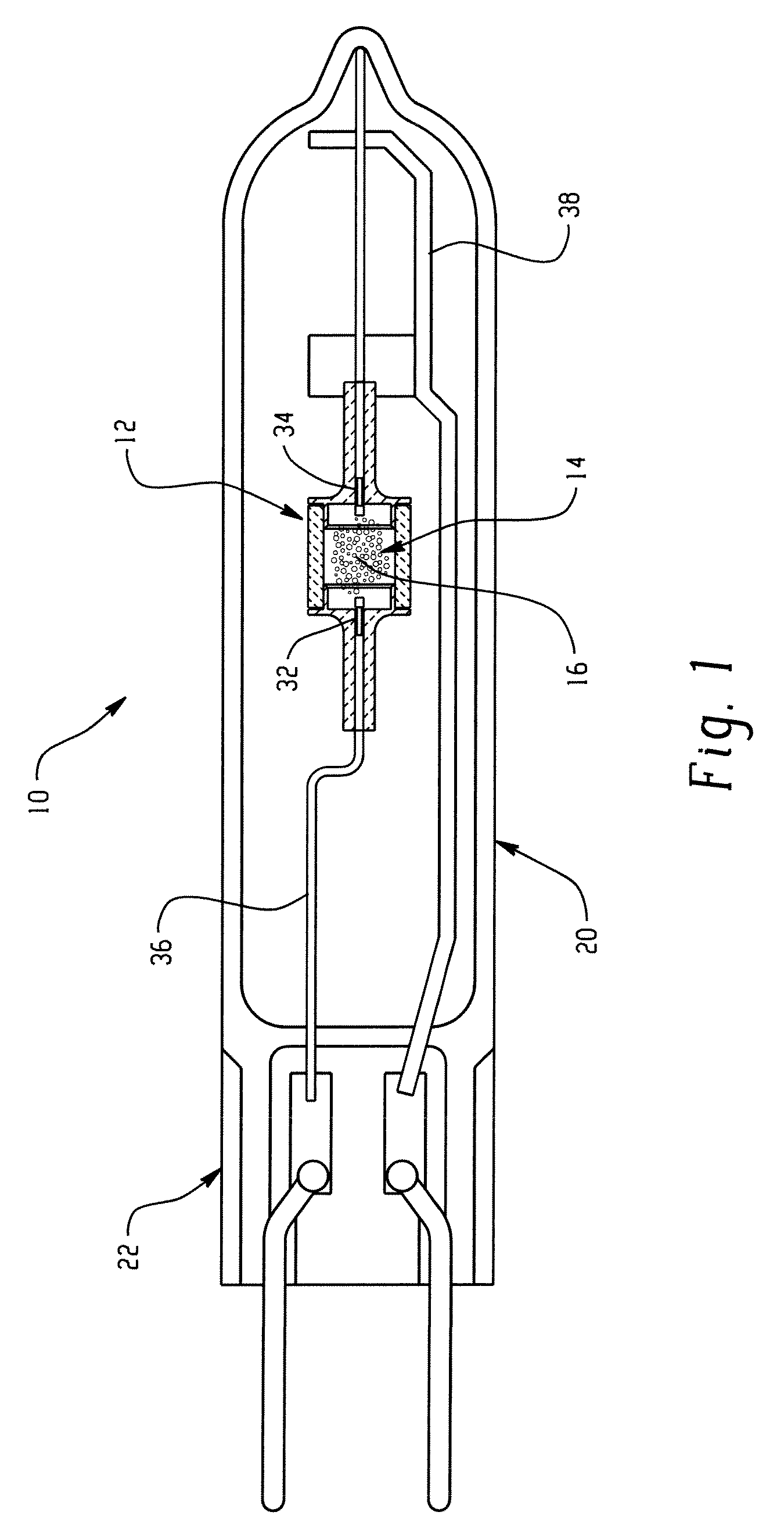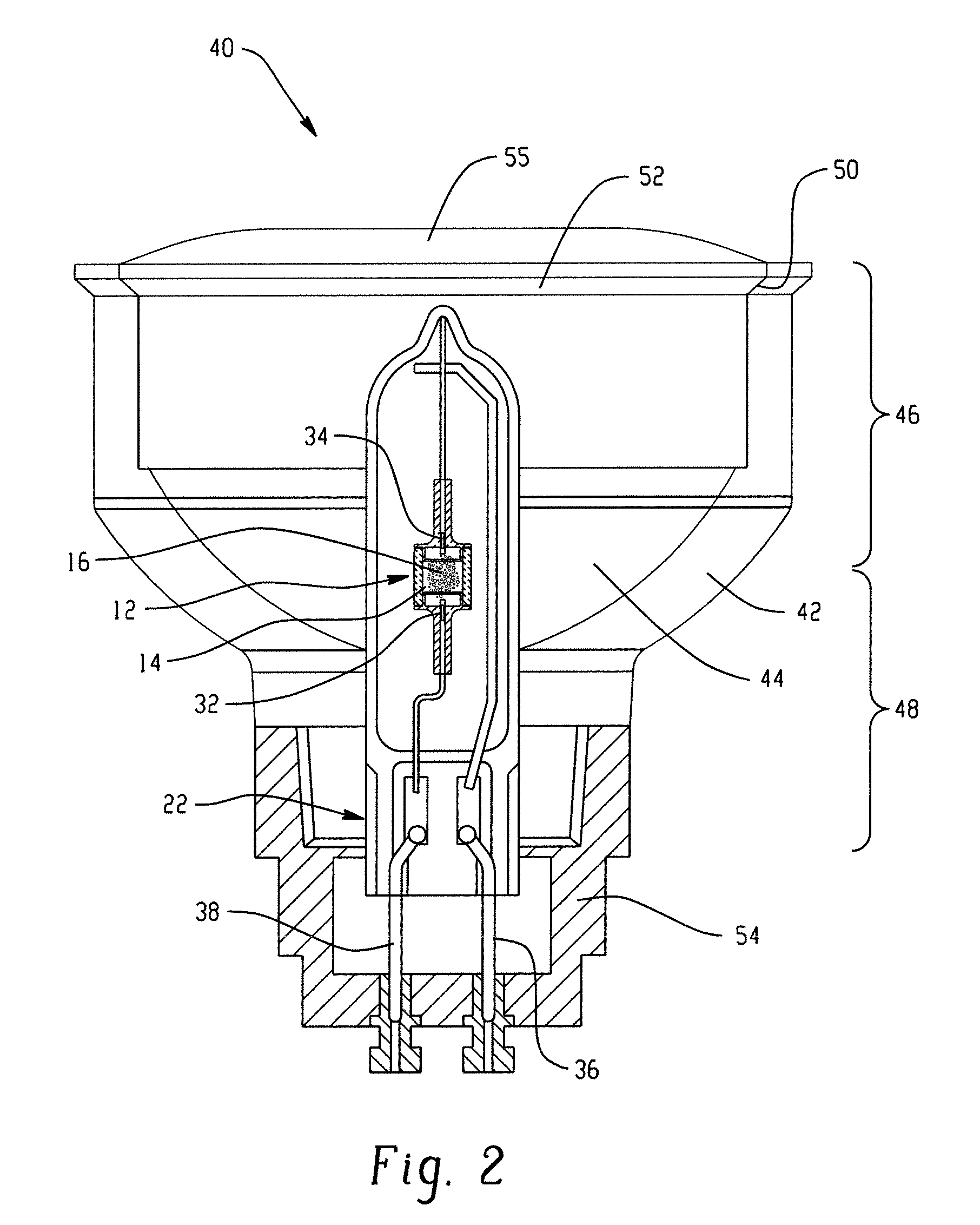Dose composition suitable for low wattage ceramic metal halide lamp
a technology of ceramic metal halide and composition, which is applied in the manufacture of electric discharge tubes/lamps, gaseous cathodes, electrode systems, etc., can solve the problems of depletion of fill constituents, reactive properties of fused quartz, and certain properties at high operating temperatures
- Summary
- Abstract
- Description
- Claims
- Application Information
AI Technical Summary
Benefits of technology
Problems solved by technology
Method used
Image
Examples
example 1
[0074]A 39W Ceramic Metal Halide Single-Ended lamp according to the embodiment shown in FIG. 1, was formed with an arc gap of 4.65 mm, a barrel length L of 7.3 mm, a dose weight of 8.8 mg, or 47.2 mg / cc and mole fractions of: NaI: 0.562, TlI: 0.022, CaI2: 0.305, and LaI3: 0.111 (totaling 1.0) in a fill containing mercury (5.7 mg) and argon gas at a fill pressure of 120 Torr. Table 2 illustrates additional properties of the lamp.
TABLE 2Test CellSample AWall Thickness Tb (mm)0.6Plug Thickness Tp (mm)0.6Plug Depth d (mm)1.8Inner Diameter D (mm)5.7Tip-To-Plug TTP (mm)1.33Wall Loading WL (W / cm2)21.5Lumens (LPW) @ 100 hours90CCT (degrees K)3012CRI (Ra)86dCCY−0.004Maximum Wall Temperature (degrees K)1380
example 2
[0075]A 39W Ceramic Metal Halide lamp, housed in a lamp housing having a reflective interior surface as illustrated in FIG. 2, was formed with an arc gap of 4.65 mm, a barrel length L of 7.3 mm, a dose weight of 6.4 mg, or 34.4 mg / cc and mole fractions of: NaI: 0.574, TlI: 0.021, CaI2: 0.297, and LaI3: 0.108 (totaling 1.0) in a fill containing mercury (5.5 mg) and argon gas at a fill pressure of 120 Torr. Table 3 illustrates a lower LPW for a CMH lamp housed in a lamp having a reflecture compared to a lamp without a housing. Table 3 illustrates additional properties of the lamp.
TABLE 3Test CellSample BWall Thickness Tb (mm)0.6Plug Thickness Tp (mm)0.6Plug Depth d (mm)1.8Inner Diameter D (mm)5.7Tip-To-Plug TTP (mm)1.33Wall Loading WL (W / cm2)21.5Lumens (LPW) @ 100 hours63CCT (degrees K)3050CRI (Ra)89dCCY−0.002Maximum Wall Temperature (degrees K)1450
As can be seen from Table 3, there was a loss in lumen output resulting from the use of a lamp housing, although, other properties were su...
example 3
[0076]A 39W Ceramic Metal Halide Single-Ended lamp according to the embodiment shown in FIG. 1, was formed with an arc gap of 4.65 mm, a barrel length L of 7.6 mm, a dose weight of 8.0 mg, or 41.25 mg / cc and mole fractions of: NaI: 0.677, TlI: 0.047, CaI2: 0.201, and LaI3: 0.074 (totaling 1.0) in a fill containing mercury (5.3 mg) and argon gas at a fill pressure of 120 Torr. Table 4 illustrates additional properties of the lamp.
TABLE 4Test CellSample DWall Thickness Tb (mm)0.6Plug Thickness Tp (mm)0.6Plug Depth d (mm)1.8Inner Diameter D (mm)5.7Tip-To-Plug TTP (mm)1.48Wall Loading WL (W / cm2)20.8
[0077]In another study, targets for photometric values were established as follows:
La Mole Fraction0.08Lumens3590CRI87CCT2900dCCy0.001
[0078]In one experiment, the mole fraction of lanthanum halide in lamps otherwise similar to those of Example 1 was varied at 3 levels (0.05, 0.08, and 0.11 mol fraction). However, the results indicated that the lamps with the 0.08 mol fraction most closely mat...
PUM
 Login to View More
Login to View More Abstract
Description
Claims
Application Information
 Login to View More
Login to View More - R&D
- Intellectual Property
- Life Sciences
- Materials
- Tech Scout
- Unparalleled Data Quality
- Higher Quality Content
- 60% Fewer Hallucinations
Browse by: Latest US Patents, China's latest patents, Technical Efficacy Thesaurus, Application Domain, Technology Topic, Popular Technical Reports.
© 2025 PatSnap. All rights reserved.Legal|Privacy policy|Modern Slavery Act Transparency Statement|Sitemap|About US| Contact US: help@patsnap.com



